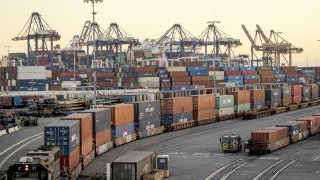
The Port of Los Angeles, the busiest port in North America, saw record volume in 2021.
Container volume at the port, including imports like furniture and apparel, surged to a record 10.6 million TEUs in 2021, almost 16% higher than the previous year.
A TEU, or twenty-foot equivalent unit, is the industry standard to measure cargo capacity for ships and terminals. One 20 foot container can hold about 400 flat-screen TVs.
But along with that volume came an array of headwinds impacting everyone from retail stores and large manufacturers to port-side communities.
We're making it easier for you to find stories that matter with our new newsletter — The 4Front. Sign up here and get news that is important for you to your inbox.
As of February 16 there was a backlog of more than 70 container ships drifting, slow steaming or waiting outside the Port of Los Angeles. At the same time there were almost 62,000 empty containers at the port's terminal and off-dock depots.
"Throughout the last two years, you've had economies opening and closing and ports doing the same, and factories and all the rest, workers getting sick, truckers being out of work and all of those little mismatches, along with some kind of fundamental ones, between different countries have thrown our supply chains out of balance," said Scott Lincicome, a senior fellow at the Cato Institute.
Port congestion also has health implications for the surrounding community.
Money Report
With the logjam of ships idling near the San Pedro Bay ports in October, pollution increased to roughly the equivalent of the emissions from 5.8 million passenger cars.
Trucks, trains and terminal equipment are another source of pollution. Freight transportation is linked to higher rates of asthma, cancer and other illnesses, according to the Clean Air Coaltion.
"The ports are a massive economic hub, there's no denying it, there's no denying their global importance, but the impact on people's health, the impact on people's quality of life, and the impact on how long they live can also not be denied," said Chris Chavez, Deputy Policy Director, Coalition for Clean Air.
And it has had worldwide implications, too. In November, 11.5% of global vessel capacity was, in effect, offline as ships waited in queues, according to Sea-Intelligence, a Copenhagen-based maritime data firm.
So, what is causing the bottlenecks at West Coast ports and what steps are being taken to ease the congestion? Watch the video to learn more.
Watch more:
Can The North Face compete with Patagonia?
How airlines are dealing with rising air rage cases






